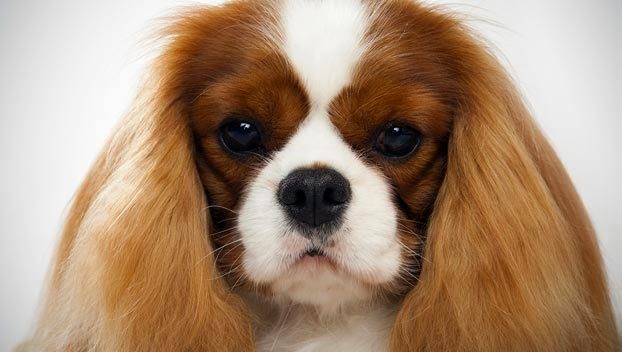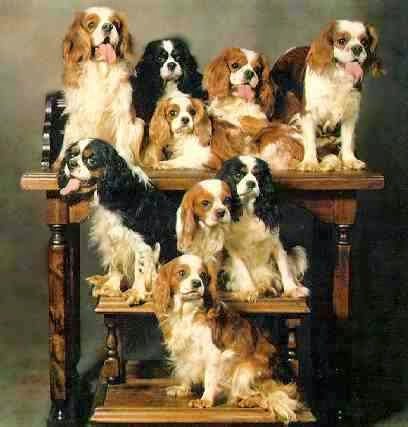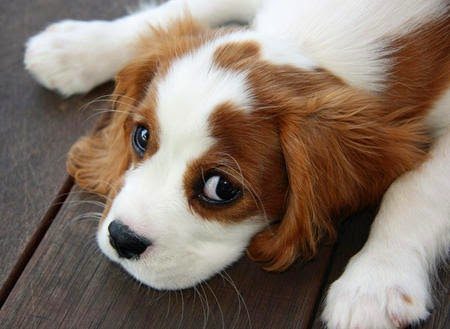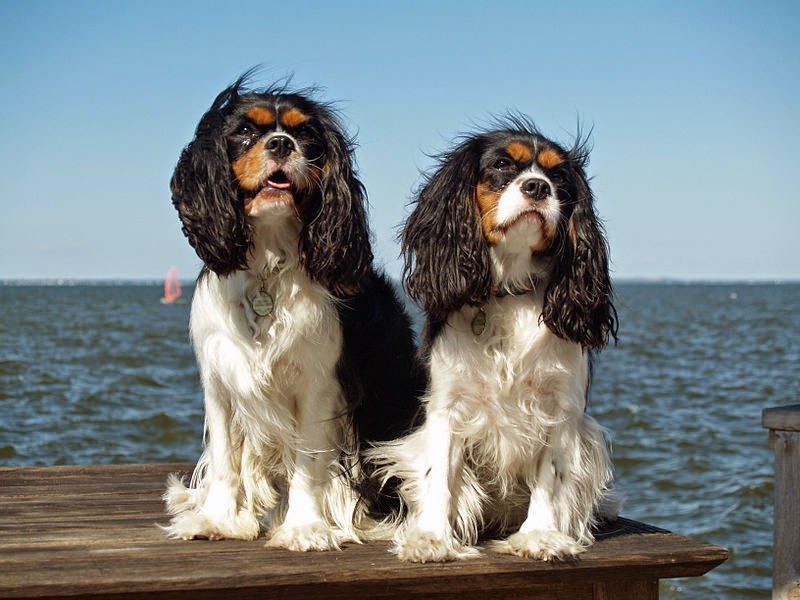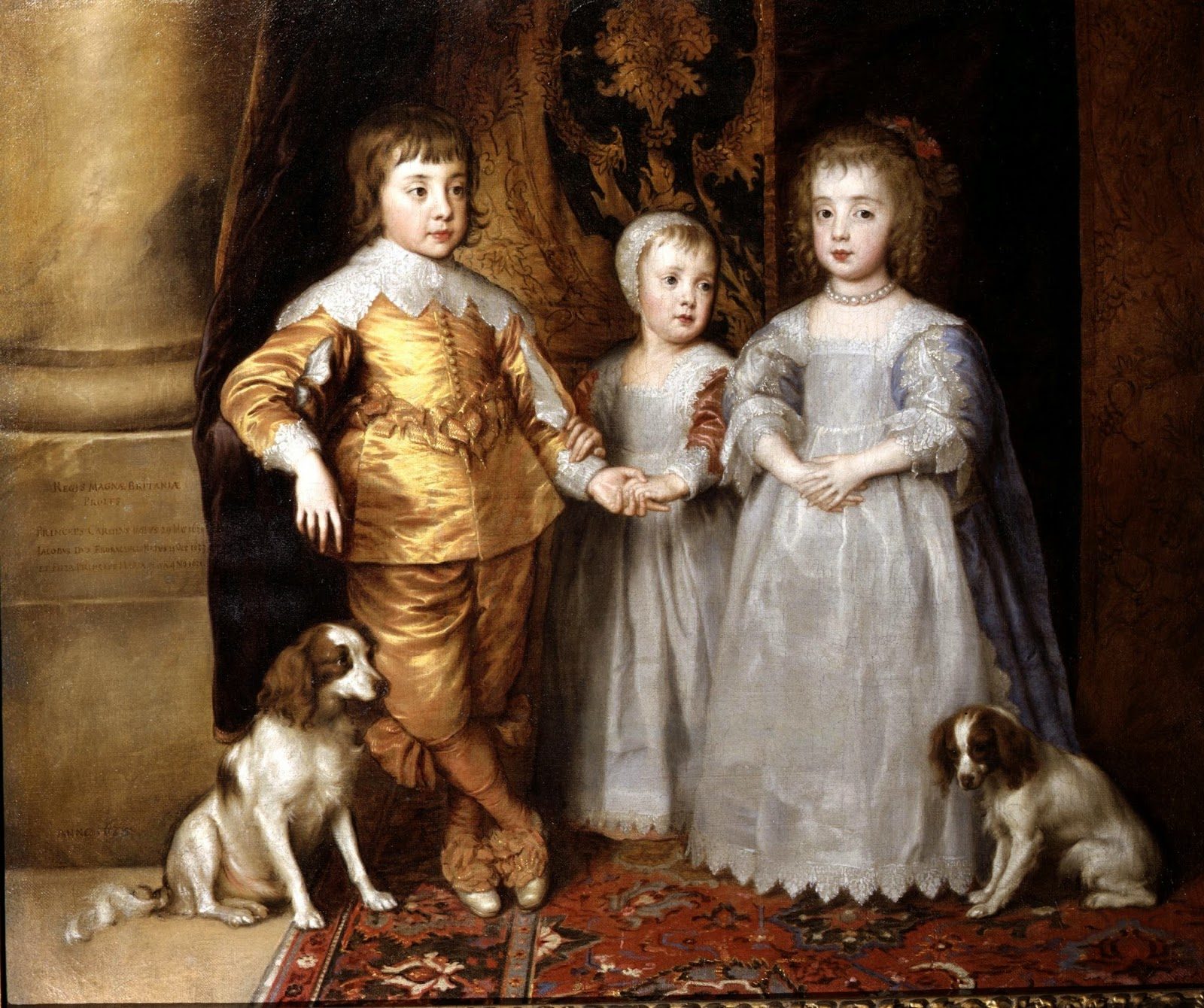One of the largest of the Toy breeds, Cavaliers follow their people everywhere, just waiting for a chance to jump in a lap. They are also willing and able to go for long walks and hikes, and many enjoy flushing birds, just like their bigger spaniel cousins.
Although he’s born to be a companion, the Cavalier King Charles Spaniel dog breed retains the sporty nature of his spaniel ancestors. If he’s not sitting on a lap or getting a belly rub, nothing makes him happier than to flush a bird and then attempt to retrieve it. One of the largest of the toy breeds, he’s often as athletic as a true sporting breed and enjoys hiking, running on the beach, and dog sports such as agility, flyball and rally. Some have even shown their prowess as hunting dogs. The more restful members of the breed find success as family friends and therapy dogs.
Overview

The Cavalier King Charles Spaniel is a beautiful small dog that undoubtedly is a contender for the title of “top tail-wagger.” In fact, among the characteristics that Cavalier breeders strive to attain is a tail in constant motion when this breed is moving.
If the characteristic wagging of the Cavalier’s plumy tail doesn’t melt your heart, surely his large, dark round eyes will. Warm and lustrous, with a sweet expression, they hold the power to extract constant petting and unlimited supplies of food from people under their spell. Not surprisingly, this breed can easily become fat, which spoils its lovely lines, so be strong and offer a walk or playtime instead of the potato chips and pizza your Cavalier is angling for.
Cavaliers pad through the house on slippered paws, always following in the footsteps of their people. With a Cavalier in residence, you’ll never be alone — not even in the bathroom. Because they’re so attached to their people, they do best when someone is at home during the day to keep them company. They are a housedog and will never thrive in an environment where they’re relegated to the backyard or otherwise ignored.
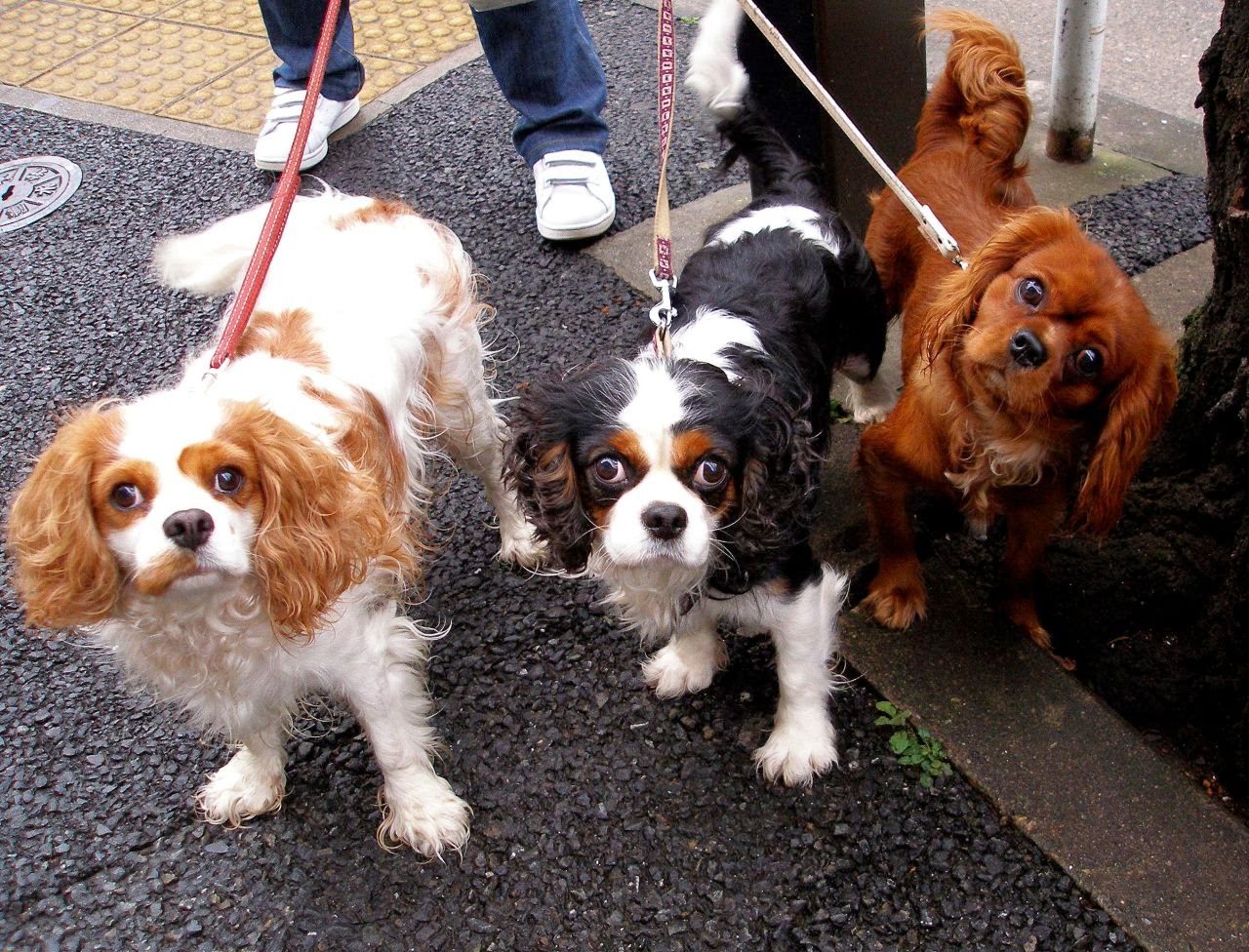
When it comes to training, Cavaliers are generally intelligent and willing to try whatever it is you’d like them to do. Food rewards and positive reinforcement help ensure that training goes smoothly. Cavaliers have a soft personality, so yelling at them is counterproductive and likely to send these sweeties into the sulks or into hiding. Instead, reward them every time you see them doing something you like, whether it’s chewing on a toy instead of your Prada pumps or not barking in response when the dog next door barks. They’ll fall all over themselves to find more things that you like.
As with many toy breeds, Cavaliers can have issues with housetraining, but if you keep them on a consistent schedule, with plenty of opportunities to potty outdoors, they can become trustworthy in the home.
Highlights
- Cavaliers have a dependent personality. They love to be with people and shouldn’t be left alone for long periods of time.
- Your Cavalier will shed, especially in the spring and fall. Regular combing and brushing is required.
- Because he’s a spaniel at heart, he may try to chase birds, rabbits and other small prey if he isn’t kept on leash or in a fenced yard.
- Cavaliers may bark when someone comes to your door, but because of their friendly nature, they aren’t good guard dogs.
- Cavaliers are housedogs and should not live outdoors.
- To get a healthy dog, never buy a puppy from an irresponsible breeder, puppy mill, or pet store. Look for a reputable breeder who tests her breeding dogs to make sure they’re free of genetic diseases that they might pass onto the puppies, and that they have sound temperaments.
- Cavaliers have a silky, medium-length coat with feathering on the ears, legs, chest, feet and tail. They shed moderately.
- The Cavalier coat comes in four colors: Blenheim (chestnut and white), tricolor (black and white with tan points over the eyes, on the cheeks, inside the ears and beneath the tail), ruby (solid red) and black and tan (black with tan points like those on the tricolor).
- Cavaliers can get along with cats when they are raised with them, but some have a strong prey drive and will chase cats. Pet birds should also watch their tailfeathers around Cavaliers.
Breed standards
- AKC group: Toy
- UKC group: Terrier
- Average lifespan: 10 – 12 years
- Average size: 8 – 14 pounds
- Coat appearance: Silky, medium-length
- Coloration: Tricolored (beige, white and black), ruby, red and white, black and tan
- Hypoallergenic: No
- Other identifiers: Dark eyes and dark-eyed rims; well-proportioned body; scissor-bite teeth; long ears with feathering and medium length coat
- Possible alterations: Dewclaws may be removed
- Comparable Breeds: Bichon Frise, Cocker Spaniel
History
During the early part of the 18th century, John Churchill, 1st Duke of Marlborough, kept red and white King Charles type spaniels for hunting. The duke recorded that they were able to keep up with a trotting horse. His estate was named Blenheim in honour of his victory at the Battle of Blenheim. Because of this influence, the red and white variety of the King Charles Spaniel and thus the Cavalier King Charles Spaniel became known as the Blenheim.
Attempts were made to recreate the original King Charles Spaniel as early as the turn of the 20th century, using the now extinct Toy Trawler Spaniels. These attempts were documented by Judith Blunt-Lytton, 16th Baroness Wentworth, in the book “Toy Dogs and Their Ancestors Including the History And Management of Toy Spaniels, Pekingese, Japanese and Pomeranians” published under the name of the “Hon. Mrs Neville Lytton” in 1911.
Divergence from King Charles Spaniel
In 1926, American Roswell Eldridge offered a dog show class prize of twenty-five pounds each as a prize for the best male and females of “Blenheim Spaniels of the old type, as shown in pictures of Charles II of England’s time, long face, no stop, flat skull, not inclined to be domed, with spot in centre of skull.”The breeders of the era were appalled, although several entered what they considered to be sub-par King Charles Spaniels in the competition. Eldridge died before seeing his plan come to fruition, but several breeders believed in what he said and in 1928 the first Cavalier club was formed. The first standard was created, based on a dog named “Ann’s Son” owned by Mostyn Walker,and The Kennel Club recognised the breed as “King Charles Spaniels, Cavalier type”.
World War II caused a drastic setback to the breed, with the vast majority of breeding stock destroyed because of the hardship. For instance, in the Ttiweh Cavalier Kennel, the population of sixty dropped to three during the 1940s. Following the war, just six dogs would be the starting block from which all Cavaliers descend. These dogs were Ann’s Son, his litter brother Wizbang Timothy, Carlo of Ttiweh, Duce of Braemore, Kobba of Kuranda and Aristide of Ttiweh.The numbers increased gradually, and in 1945 The Kennel Club first recognised the breed in its own right as the Cavalier King Charles Spaniel.
The history of the breed in America is relatively recent. The first recorded Cavalier living in the United States was brought from the United Kingdom in 1956 by W. Lyon Brown, together with Elizabeth Spalding and other enthusiasts, she founded the Cavalier King Charles Club USA which continues to the present day. In 1994, the American Cavalier King Charles Spaniel Club was created by a group of breeders to apply for recognition by the American Kennel Club. The Cavalier would go on to be recognised by the American Kennel Club in 1995, and the ACKCSC became the parent club for Cavaliers.
The gregarious Cavalier takes as his role model humorist Will Rogers, who famously said he never met a stranger. The Cavalier is eager to meet everyone who crosses his path, and if that person sits down and offers a lap (or a treat), so much the better.
Like any dog, Cavaliers come in a range of personalities, from quiet and sedate to rowdy and rambunctious. They might or might not bark when someone comes to the door, so they’re a poor choice as a watchdog — except, that is, for watching the burglar cart off the silver. There are exceptions, of course — some Cavaliers will inform you of every event in your neighborhood and bark ferociously when strangers approach — but overall you’re better off buying an alarm system than counting on your Cavalier to alert you to trouble.
Health
The Cavalier, which has an average lifespan of 9 to 14 years, may suffer from minor health problems such as patellar luxation, and entropion, or major problems like syringomelia, mitral valve disease (MVD), and canine hip dysplasia (CHD). Sometimes retinal dysplasia is seen in the breed. Many Cavaliers also have reduced platelet numbers, but this does not seem to cause any problems. Cardiac, eye, hip, and knee tests are suggested for this breed of dog.
Living Conditions
Cavalier King Charles Spaniels are good for apartment life. They are moderately active indoors and a small yard will be sufficient. The Cavalier does not do well in very warm conditions.
Cavalier King Charles Spaniels need a daily walk. Play will take care of a lot of their exercise needs, however, as with all breeds, play will not fulfill their primal instinct to walk. Dogs that do not get to go on daily walks are more likely to display behavior problems. They will also enjoy a good romp in a safe open area off-lead, such as a large, fenced-in yard.
Care
The Cavalier is not suited for outdoor living. Its long coat requires brushing on alternate days. The dog requires a good amount of exercise regularly, in the form of a romp in a secure area or a moderate on-leash walk.
Grooming
For a coated breed, the Cavalier is relatively easy to groom. The medium-length silky coat is not so heavy that it requires hours of brushing, and it sheds dirt easily. The Cavalier sheds, like all dogs, but regular brushing will remove dead hairs so they don’t float off onto your floor, furniture and clothing.
The long, silky hair on the Cavalier’s ears, tail, belly and legs, known as feathering, should be brushed two or three times a week to prevent mats or tangles from forming. Be sure to check behind the ears and where the leg meets the body; that’s where they commonly form. Use a slicker brush or stainless steel comb to remove tangles, then bring out shine with a bristle brush. The coat does not require any trimming for the show ring; indeed, such trimming is prohibited by the breed standard.
A bath every two to four weeks will keep the Cavalier smelling sweet. The only other grooming needed is regular ear cleaning, tooth brushing and nail trimming.
Is this breed right for you?
Perfect for families with older children, the Cavalier King Charles Spaniel is a great companion for families and one-person households. Great for apartment living, the breed will need daily walking to avoid being bored or getting himself into trouble. Preferring company, it’s best that he’s not left alone for long periods of time. A social breed, it’s also best that he’s constantly around other people to avoid being shy or reserved.
Cavaliers can be great playmates for kids who will enjoy throwing a ball for them, teaching them tricks, participating in dog sports, or simply having them on a lap while they read or watch television. Because of their small size, however, they should be supervised when playing with small children who might injure them accidentally.
As with every breed, you should always teach children how to approach and touch dogs, and always supervise any interactions between dogs and young children to prevent any biting or ear or tail pulling on the part of either party. Teach your child never to approach any dog while he’s eating or sleeping or to try to take the dog’s food away. No dog, no matter how friendly, should ever be left unsupervised with a child.
They get along well with other dogs and can learn to play nice with cats and other pets if introduced to them at an early age. It helps if the cat is willing to stand up for herself because a Cavalier enjoys a good game of chase. They even enjoy it if the cat chases back. Some Cavaliers live peaceably with pet birds while others try to eat them — or at the very least pull their tails. Always supervise your Cavalier’s interactions with birds and other small animals; they can have a strong hunting instinct.
Did You Know?
“Sex and the City’s” Charlotte York had a Cavalier King Charles Spaniel named Elizabeth Taylor. Real-life celebrities Claire Danes, Terri Hatcher, Mischa Barton, Diane Sawyer, and Jerry O’Connell are Cavalier owners.
A dream day in the life of the Cavalier King Charles Spaniel
A loving breed, the Cavalier King Charles Spaniel will be happy waking up in the bed of his owner. Stumbling into the kitchen for his daily feeding, the pup will enjoy having a routine in place. After his feeding, you may find him waiting at the door for his daily walk. After a short nap, he’ll take a run in the backyard and finish his day snuggling on the lap of his owner while watching favorite television shows together.


